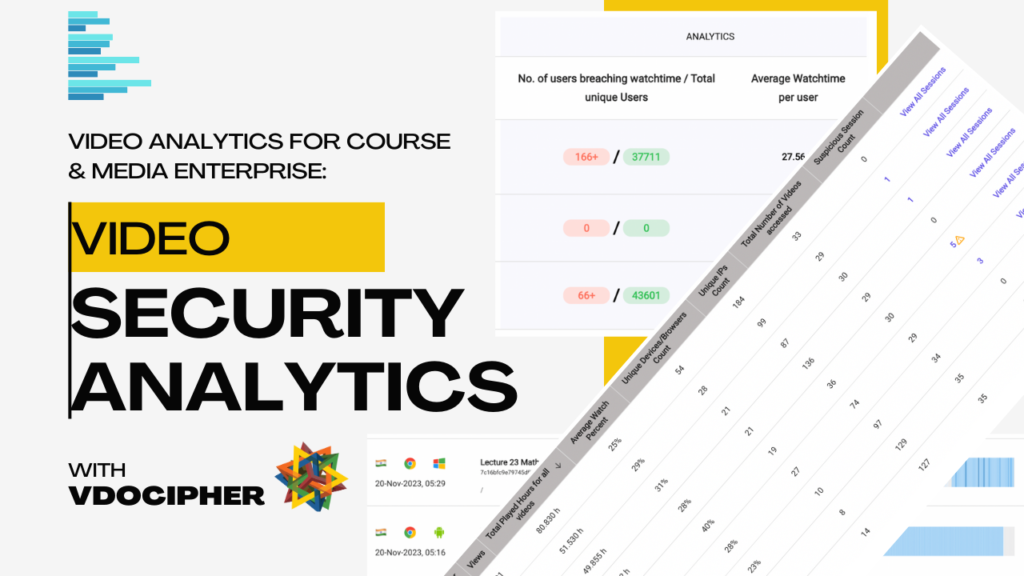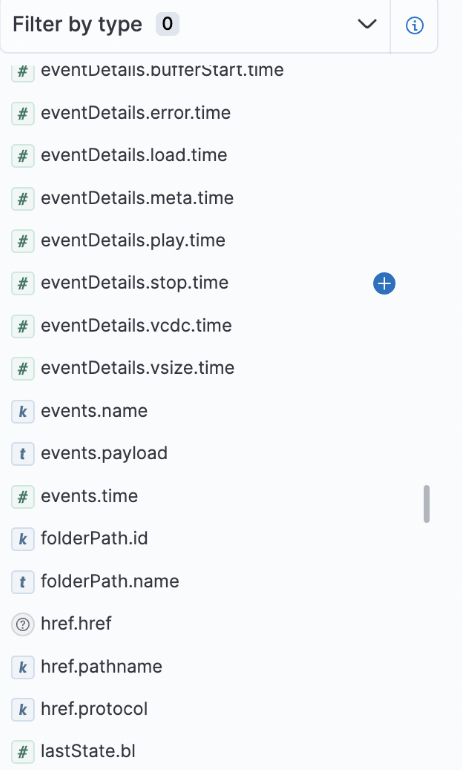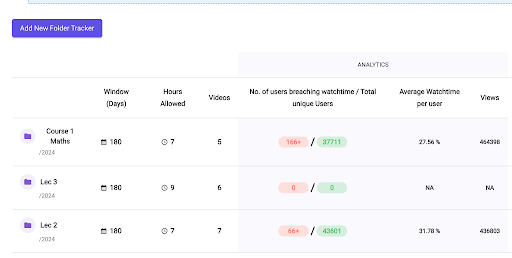Video Analytics and Video Player Analytics has been a buzzword for many years now and the hype around it has only been increasing. However many businesses are still unsure of what exact data points to look at, what analyses to make, and what changes to make in your videos/courses/movies based on the data.
In this blog, We have mentioned the key 15 metrics as examples that one should get in video analytics and how to use them to enhance viewer experience, prevent misuse, and increase revenues. The context mentioned here is both general for any use case and what can be particularly achieved with VdoCipher analytics offerings. We have also included a video at the end which shows the usage of 14 of these example metrics with the VdoCipher dashboard and APIs. Some of these aspects are unique and it is very rare in the video hosting or video DRM field for a company to provide it.
Table of Contents:
- No. of Video Views
- % distribution as per devices/platforms
- % distribution as per geography
- % Watch completion for a particular video and the whole course/folder
- Total watch time for a particular video and whole course/folder
- No. of unique devices for each subscriber/student
- No. of sessions for each subscriber/student
- Heatmap sessions for popular videos
- Quality of Experience (QoE) – Buffer rate, load time, etc.
- Error logs based on error type and device/browser split
- Playback attempts in emulator/rooted devices/non-regular devices
- Logs on which domains your video URLs are being played
- Video Analytics for web camera – Object, face, context detection
- Video Ad view analytics – skip, non-skip ads, bounce rates
- Video Parameter Analytics – Watch quality, subtitle, fullscreen, pause/repeat, etc
- Stopping Credential Sharing With the User-based Security Analytics
- FAQs
1. Number of Video Views
This is the most direct and sometimes also overused/misused metric. It measures how many times a video has been viewed, serving as a primary indicator of its popularity or reach. Some platforms only consider a view if the viewer watches the video for at least 5 seconds or 10 seconds of video. High view counts can signal successful content, but they need to be analyzed in conjunction with other metrics for a complete picture.
VdoCipher data for no. of views –
- Dashboard – Please go to the analytics section in dashboard and on the tab titled “Views”.
- Player API – You can also track and log play events and many other player events using our player API documentation.
2. Device/Platform/Browser Distribution
Understanding the viewership % on mobile devices, OS and browsers is necessary to ensure the right efforts are put in the direction needed. E.g Mobile optimized videos, iOS compatibility, etc.
VdoCipher Dashboard data – Please go to the analytics section in the dashboard and on the tab titled “Views”.
3. Geographic Distribution for video sessions
Though most businesses know the geo-distribution of their content they mostly know it through signup forms and payment data. Tracking exact ips and knowing the country’s location may sometimes spring some surprises. This can help in content localization efforts like multi-lingual subtitle, content type based on geography.
With VdoCipher, VOD and OTT platforms can now analyze viewer data effectively and apply strong security measures to prevent revenue loss and ensure content integrity.
VdoCipher Dashboard data – Please go to the analytics section in dashboard and on the tab titled “Views”. Select the “country” option on top of the pie chart.
VdoCipher Multi-lingual subtitle feature tutorial – Please go to edit (pen icon) below any video and select the subtitle section.
4. Watch Completion Rates/Average video watch percentage
What percentage of a particular video or a particular course is watched can show the engagement levels. If the completion rates or the video watch percentage are low, it is an indicator that your content is not engaging enough and it is not meeting the viewer’s expectation. Paid content has a better watchtime % expectation as compared to free content.
VdoCipher Dashboard data –
1. To check average watch % per video basis and download reports –
2. To check average watch % on per user folder/course basis – This is available in the analytics section of the dashboard but for users who are on pro plan or higher and have integrated the needed API parameter for the same.
VdoCipher Player API – totalPlayed and totalCovered parameters to track total played through APIs.
Sample dashboard analytics for video watchtime per course/folder

5. Total Video Watch Time per user
Total watch time is a parameter similar to average watch percentage and can help track video engagement. However, total watch time acts as an additional property, especially when trying to monitor misuse or overuse of content. For example, if your course content totals 50 hours and someone watches it for a total of 150 hours, it seems improbable that they would watch every video almost 3 times. This might indicate that they are sharing their login credentials and allowing other people access to the content.
Some platforms look to restrict total watch time per user , e.g restricting total watchime of 50 hour course content to 80 hours or 100 hours.
VdoCipher data for course/folder total watch time per user – This is available in analytics section of dashboard but for users who are on pro plan or higher and have integrated the needed API parameter for same.
6. Unique Devices per Subscriber
Monitoring the number of unique devices used by each subscriber or student helps in understanding viewer habits and preventing misuse like account sharing. It’s also valuable for tailoring content to the most commonly used devices.
VdoCipher Data for unique devices per user – This is available in analytics section of dashboard but for users who are on pro plan or higher and have integrated the needed API parameter for same.
7. Number of Sessions per Subscriber
Suppose you have a course with 50 lecture videos, and you figure out that 30% of users are watching all or almost all of content. Now it will be interesting to know that how much sessions it takes them to complete these 50 videos. Are they watching it all in 50-100 sessions or they are taking above 300 sessions to complete the content. While session numbers can just increase due to a person closing/refreshing the tab, but if the number is quite high, then it does mean that subscribers are spending more sessions to grab a single video, and thus you should probably reduce individual video length.
Another important aspect is again security – If no. of sessions within a single day for a particular are too high for practical use, then it again means that they are probably sharing access to multiple people or attempting downloads/screen record. At the same time it is important to note that some genuine serious learners would have such watch patterns , thus any hard action has to be taken considerately and probably by looking at individual sessions.
VdoCipher session data per user – This is available in analytics section of dashboard but for users who are on pro plan or higher and have integrated the needed API parameter for same.
8. Video Player Heatmap Sessions
Heatmaps visually represent which parts of a video are watched, skipped, or rewatched. This data is valuable to understand viewer engagement helping to fine-tune content and make it more engaging.
VdoCipher individual heatmap data – This is available in analytics section of dashboard but for users who are on pro plan or higher and have integrated the needed API parameter for same.
9. Quality of Experience (QoE) for Video Player Sessions
Factors like buffer rate, load time, and video quality/frame rate drop significantly impact the viewer experience. While VdoCipher, we do not publish this data for customers in a dashboard, but we do track each playback session and diligently track 30+ such metrices, and keep improving it over the time. Buffer rates, start load time, playback errors, experience variation with device and browser – We track them all at our end.
Sample screenshot from our database with QOE and other relevant parameters (e.g ib is is buffering parameter which is false for full session duration)
10. Video Player Error Logs
Analyzing errors by type and device/browser split helps in identifying and addressing technical issues. This ensures a smooth, uninterrupted viewing experience, which is vital for maintaining viewer satisfaction and engagement.
Errors can be due to DRM compatibility issue, backend integration issue, network issue, browser having some adware/malware installed , authentication issue etc.
VdoCipher has maintained an error code + actionable messages for such errors. We use it in 2 manners – displaying on player for better debugging of viewers and customers. We have logs, so if some user reports some new uncommon issue, we can check in logs what went wrong. This is a particular expertise which is unique differentiator of VdoCipher, as most DRM companies do not care about final errors which can be more probably with DRM compatibility issues. While at VDoCipher we handle the errors ourselves and communicate through player and tutorials appropriately.
E.g Error code 6002 and error message along with it says “Device/browser does not support premium content, Update Device/browser” – For cases where browser is outdated and can not support DRM playback.
11. Playback Attempts on Non-Regular Devices
Monitoring attempts to play content on emulators, rooted devices, or other non-standard devices is critical for content security. This helps in detecting and preventing potential piracy or unauthorized access. Again, this is something which very rare aspect which any video hosting or DRM companies look at , while VdoCipher has an innovative proprietary technology looking at such cases, blocking and logging them, and also showcasing them in dashboard (dashboard only for pro plan and higher cases, but blocking is automatic for all accounts).
Leverage VdoCipher’s sophisticated analytics to gain insights into viewer behavior and enhance security for your eLearning platforms, ensuring both content protection and revenue growth.
12. Domain playback Logs
Understanding where your video URLs are being played is crucial for content security and preventing illegal sharing of urls outside your platform.
Vdocipher also provides a domain restriction feature to prevent this from happening.
Domain Restriction Tutorial with VdoCipher – Go to vdocipher dashboard “Security Settings” tab and here you can put one or multiple domains where you want to restrict the playback.
Also, on request in case of any issue at your side, we can also detect from our logs, if your videos are playing on any other domain.
13. Webcam Video Analytics
This is relevant for webcam setups in public places like shopping malls, kitchens, restaurants, roads, and factories. Detecting faces, events, and any anomalies can help automate critical security aspects, or maintain quality or automate processes. This is a different kind of analytics, which vdocipher currently does not provide as we do not provide web camera setups or live stream object analytics.
14. Video Ad View Analytics
Analyzing how viewers interact with ads, including skip rates and bounce rates, is essential for platforms relying on ad revenue. This data can guide more effective ad placements and formats, balancing monetization with viewer experience. VdoCipher currently does not support ad based monetisation.
15. Video Player Parameter Analytics
Understanding how viewers use different video features, like quality settings, subtitles, full-screen mode, or the frequency of pauses and replays, can provide insights into viewer preferences and help in optimizing the user interface and experience. VdoCipher player events support some of these functionalities and some are not supported for customers, but we do track them at our end to improve our player over time.
Video showcasing the use of these key parameters with the VdoCipher dashboard & API.
Each of these metrics offers a unique perspective on viewer engagement, content effectiveness, and security aspects. By analyzing and working on these data points, course creators and media platform owners can make informed decisions to enhance the viewer experience, secure their content, and ultimately drive higher revenues.
16. Stopping Credential Sharing With the User-based Security Analytics
With the help of parameters like total watch time per user and user device analytics, you can identify if a user is watching much more content than an average user. Let’s say your course content is 8 hours and an average user consumes content about 10 to 15 hours, anyone consuming more than 20 hours or more might be possibly sharing his credentials with others thus racking in a much higher number of content consumed.
Also, with user device analytics you can see how many devices and browsers is a user utilizing to access your content. For any user with a very high number of devices, there is a high chance that the credential is being shared.
You can get the user ID of these accounts and use it to block the playback of these accounts. Also, you can contact these users and warn them of their behavior and take any action against it as well.
FAQs
What is the Importance of Tracking the Number of Video Views?
The number of video views is a crucial metric that measures how many times a video has been viewed. It serves as a primary indicator of a video’s popularity or reach. High view counts can signal successful content but need to be analyzed with other metrics for a complete picture.
How Does Device/Platform/Browser Distribution Impact Video Analytics?
Understanding the viewership percentage on various devices, operating systems, and browsers is essential. This knowledge helps in making informed decisions about optimizing videos for specific platforms like mobile devices or ensuring compatibility with particular operating systems like iOS.
Why is Geographic Distribution Important in Video Analytics?
Geographic distribution provides insights into where video content is viewed, which can offer surprising information beyond what is known from signup forms and payment data. This information is valuable for content localization efforts, such as adding multi-lingual subtitles or tailoring content based on geography.
How does VdoCipher’s Password Sharing Detection work?
VdoCipher’s Password Sharing Detection feature utilizes total video watch time per user to identify abnormal viewing patterns. This helps in detecting potential unauthorized sharing of user accounts, thereby enhancing account security and preventing misuse.
Video Analytics , Video DRM and Video Player Solution
15 Key Parameters to track Video Analytics Engagement, User Behaviour, Monetisation Patterns, Prevent mis-usage to increase revenues, Ensure quality of playback. Details on how VdoCipher does the same both for customers and internally.


My expertise focuses on DRM encryption, CDN technologies, and streamlining marketing campaigns to drive engagement and growth. At VdoCipher, I’ve significantly enhanced digital experiences and contributed to in-depth technical discussions in the eLearning, Media, and Security sectors, showcasing a commitment to innovation and excellence in the digital landscape.





